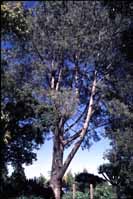 An exceptionally large tree, in its native range but on the grounds of the Quail Botanical Gardens, California [C.J. Earle, 8-Mar-1998]. | Pinus torreyana Parry ex Carrière 1855Common NamesTorrey, Soledad, lone or Del Mar pine (2).Taxonomic notesTwo varieties, torreyana and insularis (3).The distribution is disjunct, with a population on the mainland (where the type was collected) and a slightly smaller population on Santa Rosa Island. Haller (5) found differences in cone and seed shape and crown form, then describing the island population as a new subspecies, P. t. subsp. insularis Haller. This was later reduced to a variety, P. t. var. insularis (Haller) Silba (6). An earlier report on resin composition (7), and two genetic studies (8, 9) show the differences between the mainland and island populations are minimal:"No variation is detected in the chloroplast genome of Pinus torreyana" (9). Isolation of the two populations may have only occurred in the last 8000 years (9), a short time in conifer evolution terms. Even the separation time of 180,000 years suggested by Ledig & Conkle (8) is brief in comparison with the 30 million years separation between 'North Plateau' and 'Pacific' Ponderosa pines (here accepted as Pinus ponderosa subsp. ponderosa and its subsp. benthamiana), calculated using the same methodology by Critchfield (10). For this low level of differentiation, the rank of subspecies is not appropriate, with Silba's varietal combination being more suitable. DescriptionTree: Height to 15(-23) m with a dbh of up to 100 cm, in nature mostly crooked and leaning, but tall and straight in planted stands and ornamentals; crown rounded to flattened or irregular (3).Bark: Red-brown to purple-red, deeply furrowed with irregular, elongate, flat, scaly ridges (3). Branches: Irregular, spreading-ascending, resembling a candelabra; twigs stout (1-2 cm thick), green, aging deep gray-brown, rough (3). Leaves: Mostly 5 per fascicle, ascending or spreading, persisting 3-4 years, (15-)20-30(-33) cm × 2 mm, straight or curved, slightly twisted, dark green, all surfaces with fine stomatal lines, margins serrulate, apex abruptly acute; sheath to 2 cm, shed early, base persistent. Buds conic-ovoid, pale brown, to 2.5 cm; scale margins white-fringed. Leaves clustered near branch tips, giving a tufted appearance (1, 3). Cones: Lateral, massive, heavy, symmetric, ovoid before opening, broadly ovoid when open, 10-15 cm long, yellow- to red-brown, lustrous, on peducles up to 4 cm long; maturing in 3 years, shedding seeds soon thereafter, persisting to 5 years (3). Cone scales: Apophyses thick, angulately dome-shaped, with 5 low convergent keels; umbo central, forming a short, curved-tipped pyramid (3). Pollen cones: Ovoid, 20-30 mm, yellow (3). Seeds: Narrowly obovoid; body 16-24 mm, brown, apically dark brown; wing broad, oblique-tipped, to 15 mm long (3). Wood: Soft, coarse-grained (1). Similar species: RangeUSA: California: the coast at Del Mar in San Diego County, and the E end of Santa Rosa Island (2).Big TreeSee var. torreyana.OldestDendrochronologyEthnobotany"A family of the Kumenay Indians of California who owned a grove of P. torreyana managed it by burning it regularly and planting seeds to expand it (Shipek 1989)" (11) - possibly the earliest record of deliberate planting of any conifer in the New World. USDA hardiness zone 9.ObservationsRemarksAlthough P. torreyana is now a local endemic, "its distribution in Oligocene and Miocene (or at least that of its near ancestor) extended north to Oregon. Its harsh natural habitat elicits an unusually contorted and often sparse form, quite unlike the cleaner and taller form the species takes in cultivation."In terms of numbers of individuals in the wild, as well as the small area occupied by natural populations, Pinus torreyana is without a doubt the rarest North American pine. As such it is under protection. Artificial crosses between it and another, more widespread Tertiary relic, P. sabiniana, have been successful" (3). The species is being evaluated as a potentially valuable timber tree in Australia and New Zealand, where it can grow faster than P. radiata on poor sites, notably on heavy clay and shale. Growth to 20 m in 20 years is recorded in New Zealand. Seed procurement is the major barrier to increased usage. (12). Citations(1) Elias 1987.(2) Peattie 1950. (3) Kral in Flora of North America online. (5) J.R. Haller 1986. Taxonomy and relationships of the mainland and island populations of Pinus torreyana. Systematic Botany 11: 39-50. (6) J. Silba 1990. A supplement to the international census of the coniferae 2. Phytologia 68: 7-78. (7) E. Zavarin, W. Hathaway, T. Reichert & Y.B. Linhart 1967. Chemotaxonomic study of Pinus torreyana turpentine. Phytochemistry 6: 1019-1023. (8) F.T. Ledig & M.T. Conkle 1983. Gene diversity and genetic structure in a narrow endemic, Torrey pine. Evolution 37: 79-85. (9) E.R. Waters & B.A. Schaal 1991. No variation is detected in the chloroplast genome of Pinus torreyana. Canadian Journal of Forest Research 21: 1832-1835. (10) W.B. Critchfield. Crossability and relationships of Washoe pine. Madroño 31: 144–170 (1984). (11) Chapter 1, table 1.2 in Richardson 1998. (12) D. Spencer 1991. Torrey pine: an example of how the appearance of a species in its natural habitat can be deceptive. Newsletter Conif. Soc. Austral. 9: 10. See also the FEIS database. This page co-edited with M.P. Frankis, Mar-1999. |
[Pinus] [Pinaceae] [home] This page is from the Gymnosperm Database |